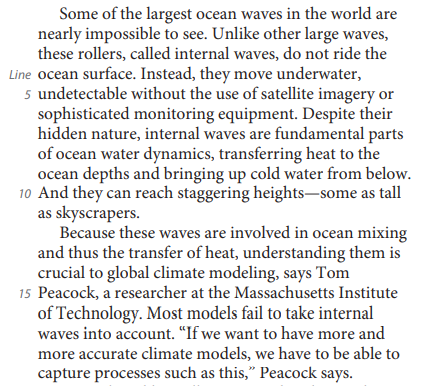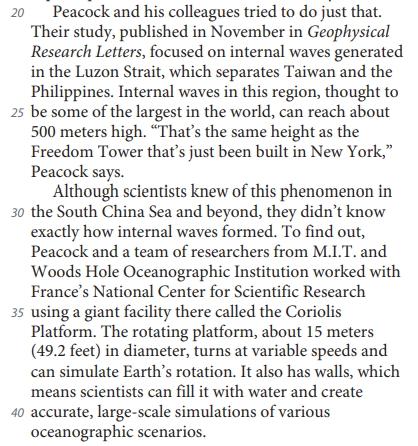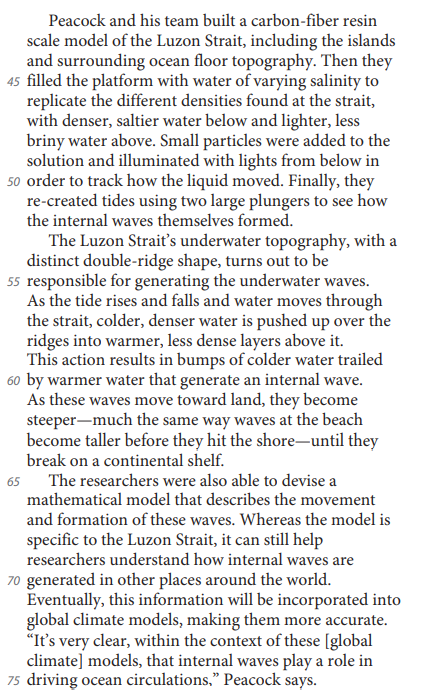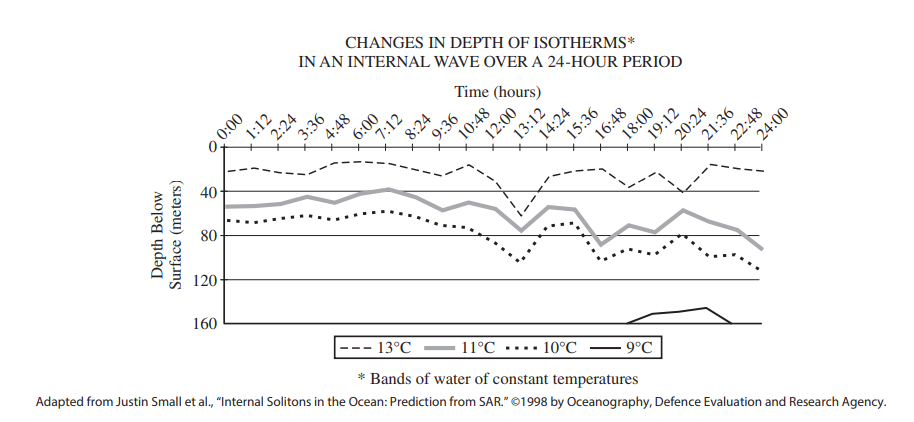SAT (Scholastic Assessment Test) is a standard test, used for taking admission to undergraduate programs of universities or colleges of the United States. SAT is developed and published by the College Board, an organization in the United States, administered by the Educational Testing Service. In this article of AKVTutorials, you will get SAT Practice Test 10 Answers | SAT 2024 Prep Online Classes AMBiPi.
SAT Reading Practice Passage
This passage is adapted from Geoffrey Giller, “Long a Mystery, How 500-Meter-High Undersea Waves Form Is Revealed.” ©2014 by Scientific American.




SAT Reading Comprehension Practice Test Questions
SAT Practice Test 10 Question No 1
The first paragraph serves mainly to
Option A: explain how a scientific device is used.
Option B: note a common misconception about an event.
Option C: describe a natural phenomenon and address its importance.
Option D: present a recent study and summarize its findings.
SAT Practice Test 10 Answer No 1
Show/Hide Answer
Option C :
In the first paragraph, the author identifies the natural phenomenon “internal waves” (line 3) and explains why they are important: “internal waves are fundamental parts of ocean water dynamics, transferring heat to the ocean depths and bringing up cold water from below” (lines 7-9).
Choices A, B, and D are incorrect because they do not identify the main purpose of the first paragraph, as that paragraph does not focus on a scientific device, a common misconception, or a recent study.
SAT Practice Test 10 Question No 2
As used in line 19, “capture” is closest in meaning to
Option A: control.
Option B: record.
Option C: secure.
Option D: absorb.
SAT Practice Test 10 Answer No 2
Show/Hide Answer
Option B :
In lines 17-19, researcher Tom Peacock argues that to create precise global climate models, scientists must be able to “capture processes” such as how internal waves are formed. In this context, to “capture” a process means to record it for scientific study.
Choices A, C, and D are incorrect because in this context “capture” does not mean to control, secure, or absorb.
SAT Practice Test 10 Question No 3
According to Peacock, the ability to monitor internal waves is significant primarily because
Option A: it will allow scientists to verify the maximum height of such waves.
Option B: it will allow researchers to shift their focus to improving the quality of satellite images.
Option C: the study of wave patterns will enable regions to predict and prevent coastal damage.
Option D: the study of such waves will inform the development of key scientific models.
SAT Practice Test 10 Answer No 3
Show/Hide Answer
Option D :
In lines 17-19, researcher Tom Peacock argues that scientists need to “capture processes” of internal waves to develop “more and more accurate climate models.” Peacock is suggesting that studying internal waves will inform the development of scientific models.
Choices A, B, and C are incorrect because Peacock does not state that monitoring internal waves will allow people to verify wave heights, improve satellite image quality, or prevent coastal damage.
SAT Practice Test 10 Question No 4
Which choice provides the best evidence for the answer to the previous question?
Option A: Lines 1-2 (“Some… see”)
Option B: Lines 4-6 (“they… equipment”)
Option C: Lines 17-19 (“If… this”)
Option D: Lines 24-26 (“Internal… high”)
SAT Practice Test 10 Answer No 4
Show/Hide Answer
Option C :
In lines 17-19, researcher Tom Peacock provides evidence that studying internal waves will inform the development of key scientific models, such as “more accurate climate models.”
Choices A, B, and D are incorrect because they do not provide the best evidence that studying internal waves will inform the development of key scientific models; rather, they provide general information about internal waves.
SAT Practice Test 10 Question No 5
As used in line 65, “devise” most nearly means
Option A: create.
Option B: solve.
Option C: imagine.
Option D: begin.
SAT Practice Test 10 Answer No 5
Show/Hide Answer
Option A :
In lines 65-67, the author notes that Tom Peacock and his team “were able to devise a mathematical model that describes the movement and formation of these waves.” In this context, the researchers devised or created, a mathematical model.
Choices B, C, and D are incorrect because in this context “devise” does not mean to solve, imagine, or begin.
SAT Practice Test 10 Question No 6
Based on information in the passage, it can reasonably be inferred that all internal waves
Option A: reach approximately the same height even though the locations and depths of the continental shelves vary.
Option B: may be caused by similar factors but are influenced by the distinct topographies of different regions.
Option C: can be traced to inconsistencies in the tidal patterns of deep ocean water located near islands.
Option D: is generated by the movement of dense water over a relatively flat section of the ocean floor.
SAT Practice Test 10 Answer No 6
Show/Hide Answer
Option B :
Tom Peacock and his team created a model of the “Luzon’s Strait’s underwater topography” and determined that its “distinct double-ridge shape . . . [is] responsible for generating the underwater [internal] waves” (lines 53-55). The author notes that this model describes only internal waves in the Luzon Strait but that the team’s findings may “help researchers understand how internal waves are generated in other places around the world” (lines 67-70). The author’s claim suggests that while internal waves in the Luzon Strait are “some of the largest in the world” (line 25) due to the region’s topography, internal waves occurring in other regions may be caused by some similar factors.
Choice A is incorrect because the author notes that the internal waves in the Luzon Strait are “some of the largest in the world” (line 25), which suggests that internal waves reach varying heights. Choices C and D are incorrect because they are not supported by the researchers’ findings.
SAT Practice Test 10 Question No 7
Which choice provides the best evidence for the answer to the previous question?
Option A: Lines 29-31 (“Although… formed”)
Option B: Lines 56-58 (“As the… it”)
Option C: Lines 61-64 (“As these… shelf”)
Option D: Lines 67-70 (“Whereas… world”)
SAT Practice Test 10 Answer No 7
Show/Hide Answer
Option D :
In lines 67-70, the author provides evidence that, while the researchers’ findings suggest the internal waves in the Luzon Strait are influenced by the region’s topography, the findings may “help researchers understand how internal waves are generated in other places around the world.” This statement suggests that all internal waves may be caused by some similar factors.
Choices A, B, and C are incorrect because they do not provide the best evidence that internal waves are caused by similar factors but are influenced by the distinct topographies of different regions. Rather, choices A, B, and C reference general information about internal waves or focus solely on those that occur in the Luzon Strait.
SAT Practice Test 10 Question No 8
In the graph, which isotherm displays an increase in depth below the surface during the period 19:12 to 20:24?
Option A: 9°C
Option B: 10°C
Option C: 11°C
Option D: 13°C
SAT Practice Test 10 Answer No 8
Show/Hide Answer
Option D :
During the period 19:12 to 20:24, the graph shows the 13°C isotherms increasing in depth from about 20 to 40 meters.
Choices A, B, and C are incorrect because during the period 19:12 to 20:24 the 9°C, 10°C, and 11°C isotherms all decreased in depth.
SAT Practice Test 10 Question No 9
Which concept is supported by the passage and by the information in the graph?
Option A: Internal waves cause the water of varying salinity to mix.
Option B: Internal waves push denser water above layers of less dense water.
Option C: Internal waves push bands of cold water above bands of warmer water.
Option D: Internal waves do not rise to break the ocean’s surface.
SAT Practice Test 10 Answer No 9
Show/Hide Answer
Option D :
In lines 3-6, the author notes that internal waves “do not ride the ocean surface” but “move underwater, undetectable without the use of satellite imagery or sophisticated monitoring equipment.” The graph shows that the isotherms in an internal wave never reach the ocean’s surface, as the isotherms do not record a depth of 0.
Choice A is incorrect because the graph provides no information about salinity. Choice B is incorrect because the graph shows layers of less dense water (which, based on the passage, are warmer) riding above layers of denser water (which, based on the passage, are cooler). Choice C is incorrect because the graph shows that internal waves push isotherms of warmer water above bands of colder water.
SAT Practice Test 10 Question No 10
How does the graph support the author’s point that internal waves affect ocean water dynamics?
Option A: It demonstrates that wave movement forces warmer water down to depths that typically are colder.
Option B: It reveals the degree to which an internal wave affects the density of deep layers of cold water.
Option C: It illustrates the change in surface temperature that takes place during an isolated series of deep waves.
Option D: It shows that multiple waves rising near the surface of the ocean disrupt the flow of normal tides.
SAT Practice Test 10 Answer No 10
Show/Hide Answer
Option A :
In lines 7-9, the author notes that internal waves are “fundamental parts of ocean water dynamics” because they transfer “heat to the ocean depths and brin[g] up cold water from below.” The graph shows an internal wave forcing the warm isotherms to depths that typically are colder. For example, at 13:12, the internal wave transfers “heat to the ocean depths” by forcing the 10°C, 11°C, and 13°C isotherms to depths that typically are colder.
Choices B, C, and D are incorrect because the graph does not show how internal waves affect the ocean’s density, surface temperature, or tide flow.


